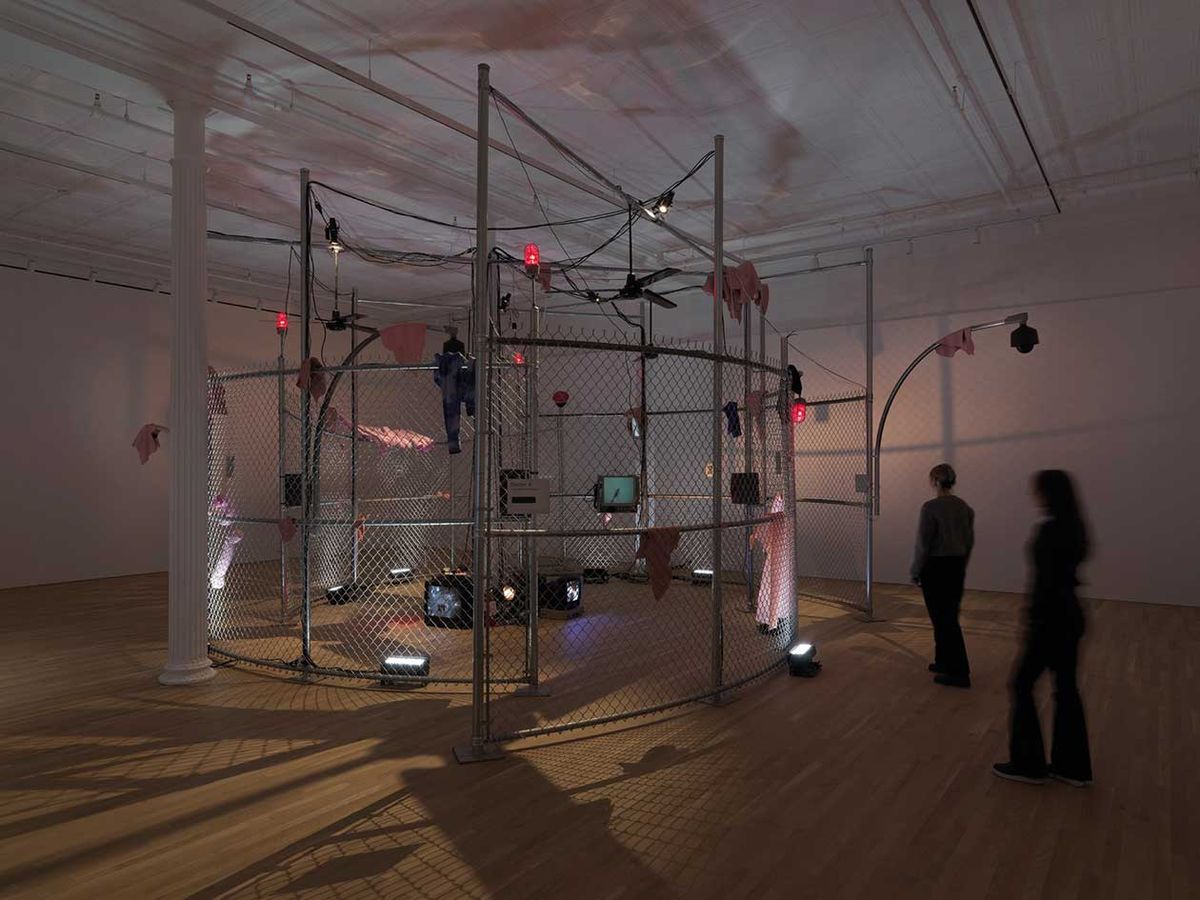Is our collective security worth the sacrifice of individual privacy? If TikTok and Instagram provide any answer, it might be that we enjoy seeing ourselves on camera too much to care.
Julia Scher thinks so. “We’ve grown accustomed to it,” she observes, sounding more like a distaff Henry Higgins than an artist clocking government and corporate spying on civilians. The Cologne-based American’s 40-year probe of the mechanics and ethics of surveillance has given her a certain expertise. “People are relaxed about it,” she says, instantly increasing my discomfort at seeing live video of myself in Security by Julia XLV, the room-size panopticon from 2002 on view with recent sculptures at her current show at the newly expanded Ortuzar Projects space in Tribeca.
In its current installation, Security by Julia XLV looks like a giant, chain-link birdcage outfitted with overhead fans simulating helicopter blades and closed-circuit video monitors. A scatter of flesh-pink latex “skins” and rolls of plush pink towels accessorise the open spiral of the fence; viewers enter and exit through wheelchair-accessible openings while speakers amplify a disconcertingly soothing female voice—Scher’s—cautioning them with such pronouncements as “Your body is not a weapon. Oh, no!” and, “This is not a test site.”
Scher first made the piece when the administration of George W. Bush sent men suspected of terrorism straight to prison, and torture, at Guantanamo Bay. Though somewhat forbidding, the installation looks almost quaint today, when what we used to think of as an Orwellian future has become so banal that invisible intrusions flow into our psyches and our bodies unimpeded.
I know drones spy on New York City streets, but because I don’t see or hear them, I never pay them any mind. I accept the biometric systems at airport security checkpoints as the price of freedom to travel. I know my smartphone is a tracking device, and that Amazon knows more about my habits than my friends. But what form would any resistance take?
Scher’s work as an artist is one answer. “It’s not useless,” she says. “But if you do resist, you’re Julian Assange and you’re in prison.”
When I wondered what dire circumstance first impelled her to engage in such pursuits, Scher replies, “It happened when I moved from Los Angeles and Palo Alto to Minneapolis.” The result of her perceived isolation in the Midwest was a longing to see and be seen—to connect. Yet her sculpture’s reflection of techno-reliant daily life as a windowless cell does not infer complicity with nefarious hidden powers. Nor does it suggest resignation as an option. Security by Julia is an active site. So what, if it’s not “real?” Its job is less to subvert, as Trevor Paglen might, than to deliver a warning—of other shoes about to drop and escape routes that are more like mazes. As Scher tells me at her exhibition’s opening, “It’s about being terrorised”—not just by military forces but by commercial entities that sell us out to advertisers. Where money leads, morals take a powder. Or, as Scher put it, “We have entered edgelessness.”
But her show, American Landscape, also offers a more fanciful taste of what less-than-heavenly species might come of AI-driven interventions into human bodies inhabiting “a maximum-security society”. Tessa—a hefty marble owl based on an architectural ornament that Scher spied on a Brooklyn rooftop—is kind of trans-futuristic. It has human male and female genitals, feathers that look more like a shag fur rug, and immobilised eyes that can look only in one direction.
A Sphinx-like, green marble dog with hybrid paws derives from Planet Greyhound, an installation of a cosmic bus station that Scher made for a 2022 exhibition at Kunsthalle Geissen, near Frankfurt, complete with an arrivals and departures board and a lounge of barber chairs. It’s amusing, when you don’t stop to think about the implications of a world where humanity has outgrown its usefulness. Then again, it takes a human brain to dream the stuff up.
• Julia Scher: American Landscape, Ortuzar Projects, until 13 April


